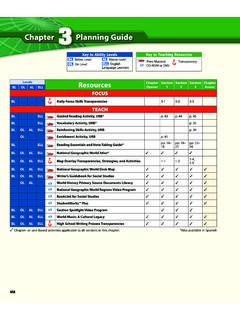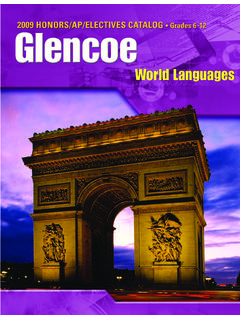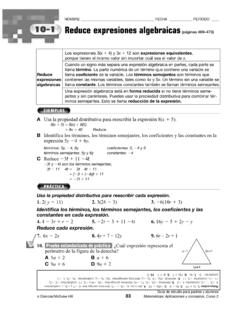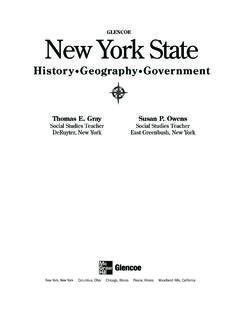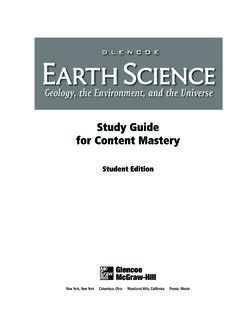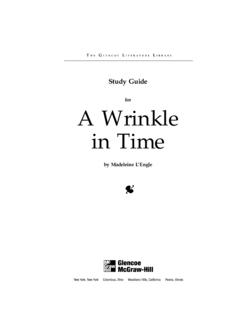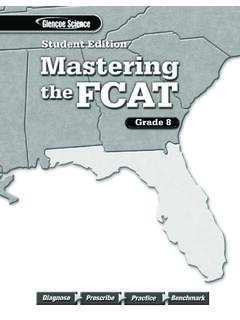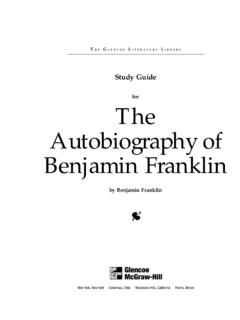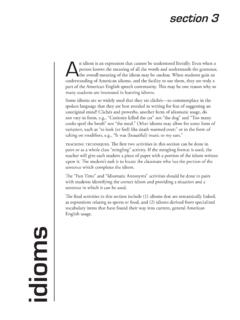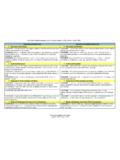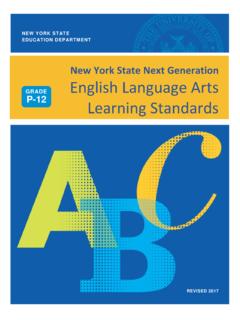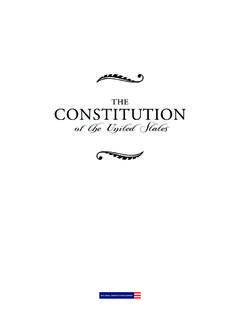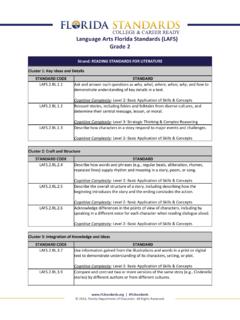Transcription of Unit 1 Resources - glencoe.com
1 unit 1 ResourcesChapter 1 The First Civilizations andEmpiresChapter 2 Ancient Greece and RomeChapter 3 Regional CivilizationsChapter 4 Toward a New WorldThe World Before Modern TimesPrehistory 1500000i-00vi FM UN01 878254 7/5/07 1:22 PM Page iBook OrganizationGlencoe offers Resources that accompany Glencoe World History: Modern Timesto expand,enrich, review, and assess every lesson you teach and for every student you THIS BOOK IS ORGANIZEDEach unit Resources book offers blackline masters at unit , chapter, and section levels. Eachbook is divided into three parts unit -based Resources , chapter-based Resources , and section-based Resources . Tabs facilitate RESOURCESWe have organized this book so that all unit Resources appear at the beginning. Althoughyou may choose to use the specific activities at any time during the course of unit study,Glencoe has placed these Resources up front so that you can review your options. For exam-ple, the Economics and History Activities and World Literature Readings appear in the frontof this book, but you may plan to use these Resources in class at any time during the study ofthe AND SECTION-BASED RESOURCESC hapter-based Resources follow the unit materials.
2 For example, Chapter 1 blackline mas-ters appear in this book immediately following unit 1 materials. The materials appear in theorder you teach Chapter 1 activities; Chapter 1 section activities; Chapter 2 activities;Chapter 2 section activities; and so on. A COMPLETE ANSWER KEYA complete answer key appears at the back of this book. This answer key includesanswers for all activities in this book in the order in which the activities by The McGraw-Hill Companies, Inc. All rights reserved. Permission is granted toreproduce the material contained herein on the condition that such material be reproduced only forclassroom use; be provided to students, teachers, and families without charge; and be used solelyin conjunction with the Glencoe World History: Modern Times program. Any other reproduction, foruse or sale, is expressly all inquiries to:Glencoe/McGraw-Hill8787 Orion PlaceColumbus, Ohio 43240-4027 ISBN: 978-0-07-878254-1 MHID: 0-07-878254-6 Printed in the United States of America1 2 3 4 5 6 7 8 9 10 079 10 09 08 07000i-00vi FM UN01 878254 7/5/07 12.
3 35 PM Page iiTable of ContentsTo the 1 ResourcesCharting and Graphing Activity and History Activity Literature Reading 1 Skills Activity Analysis Skills Activity Instruction Activity Learner Activity vocabulary Activity vocabulary Activity Reinforcement Activity Thinking Skills Activity and Geography Activity History Activity Significance Activity Learning Activity Simulation Activity Line Activity Past and Present Activity in World History Activity 1, Profile in World History Activity 1, Profile Source Reading Art and Music Activity Activity Activity 1 Section Reading Activity Reading Activity Reading Activity 2 Skills Activity Analysis Skills Activity Instruction Activity FM UN01 878254 7/11/07 12:04 PM Page iiiEnglish Learner Activity vocabulary Activity vocabulary Activity Reinforcement Activity Thinking Skills Activity and Geography Activity History Activity Significance Activity Learning Activity Simulation Activity Line Activity Past and Present Activity in World History Activity 2, Profile in World History Activity 2, Profile Source Reading Art and Music Activity Activity Activity 2 Section Reading Activity Reading Activity 3 Skills Activity Analysis Skills Activity Instruction Activity Learner Activity vocabulary Activity vocabulary Activity Reinforcement Activity Thinking Skills Activity and Geography Activity History Activity Significance Activity Learning Activity Simulation Activity Line Activity Past and Present Activity in World History Activity 3, Profile in World History Activity 3.
4 Profile Source Reading Art and Music Activity Activity Activity FM UN01 878254 7/11/07 12:11 PM Page ivChapter 3 Section Reading Activity Reading Activity Reading Activity Reading Activity 4 Skills Activity Analysis Skills Activity Instruction Activity Learner Activity vocabulary Activity vocabulary Activity Reinforcement Activity Thinking Skills Activity and Geography Activity History Activity Significance Activity Learning Activity Simulation Activity Line Activity Past and Present Activity in World History Activity 4, Profile in World History Activity 4, Profile Source Reading Art and Music Activity Activity Activity 4 Section Reading Activity Reading Activity FM UN01 878254 7/11/07 12:12 PM Page vviCharting and Graphing Activities help studentslearn and think through the use of charts and graphs. Economics and History Activities familiarize stu-dents with basic economics and its place in Literature Readings guide students throughliterature excerpts related to the Skills Activities provide specific strategiesand activities linked to chapter Analysis Skills Activities allow students topractice historical analysis Instruction Activities suggest ways toadapt chapter activities for students of all Learner Activities focus on word usage , grammar and comprehension for vocabulary relatedto chapter vocabulary Activities review and reinforcehistory terms from the student vocabulary Activities review and rein-force general academic Reinforcement Activities introduce and rein-force social studies, critical thinking, technology.
5 Andwriting Thinking Skills Activities develop indepen-dent thinking and assessment skills for history and Geography Activities guide students inusing geography to support and expand their under-standing of History Activities present maps related tochapter content for analysis and interpretation. Historical Significance Activities make connectionsfor students between past events or developments andtoday s Learning Activities enrich learningthrough group projects on historical topics and Simulation Activities explore historicalthemes and issues through games or simulations forsmall Line Activities promote students understand-ing of chronology through time-line Past and Present Activities emphasize theuniversal elements in political, social, and culturaldevelopments so students can see connections to the in World History Profiles highlight the his-torical roles of famous figures in world Source Readings guide students throughprimary excerpts and offer meaningful questions on Art and Music Activities show students howart and music shape and reflect the history of Activities help students see relation-ships betweeen historical events through the use ofgraphic organizers.
6 Enrichment Activities introduce content related tothe themes and topics in the Reading Activities present outlines, sen-tences, and other exercises for students to complete asthey read along in the the Teacher000i-00vi FM UN01 878254 7/5/07 12:35 PM Page viUNIT11 unit 1 ResourcesThe World Before Modern Times Prehistory 1500 CHARTING ANDGRAPHINGACTIVITY1 Early Traders and Empire Builders3 ECONOMICS ANDHISTORYACTIVITY1 Learning About Economics5 WORLDLITERATUREREADING1 From the Iliad: Book 1: The Quarrel9001-014 UN01 878254 7/5/07 12:45 PM Page 1001-014 UN01 878254 7/5/07 12:45 PM Page 2 UNIT13 Name Date Class ChartingandGraphingActivity1 Early Traders and Empire BuildersDirections:Complete the following web diagrams to review the major achievements of earlycivilizations and empires.
7 Use your textbook for reference as you fill in the PeoplesCulturesInnovations andAchievementsLocationsEmpire BuildersCulturesInnovations andAchievementsLocationsCopyright Glencoe/McGraw-Hill, a division of The McGraw-Hill Companies, UN01 878254 7/5/07 12:45 PM Page 3001-014 UN01 878254 7/5/07 12:45 PM Page 4 UNIT15 Name_____Date _____Class _____Needs and WantsPeople often think of eco-nomics as being exclusively the study ofmoney and business. However, the field ofeconomics actually goes far beyond is the system of distributingresources filling unlimited needs and wantswith limited products and are the requirements for human beings have three basic needs: theneed for food, the need for clothing, and theneed for shelter. In some ways, everything elsethat people seek to acquire could be consid-ered a want. However, there is more to it thanjust that. Sometimes there are additional needsassociated with meeting the three basic example, a person might need a car to getto work so that he or she can earn money tobuy food, buy clothing, and pay the rent.
8 Inthis situation, the car can be considered a basicneed. But ask yourself this question: Does theperson need a car with air-conditioning, a CDplayer, and automatic windows? Are theseneeds or are these wants? In this instance, the line between a needand a want is somewhat blurred. As the waysin which people meet their basic needsbecome even more complex, society shouldexpect that the line between a need and awant may become even harder to earliest economies those of families and small groups of people were driven by self-sufficiency. Each family orsmall group was economically independent. Inmost cases, family members in a specificgroup worked together to meet the needs ofeach other. Families hunted for the food thatonly they needed; they constructed shelters inwhich only they would live; and they sharedin the tasks of gathering and using resourcesto make clothing again, only for their ownfamily or group members. Soon, large num-bers of families, then groups, began living incloser proximity to each other.
9 The rise of civi-lization had begun. The six basic characteristics of a civilizationare cities, government, religion, social struc-ture, writing, and art. The development ofcities, governments, and social structures isintricately linked to economic development,specifically the change in human beings frombeing economically self-sufficient to becomingeconomically InterdependenceOver time peo-ple began to specialize, or gain expertise, injobs related to the three basic needs. For exam-ple, instead of making clothes for his or herown family, a person would become such anexpert at making clothes that other people inthe community would choose to buy thoseclothes as opposed to making their own. Ofcourse, not everyone became a skilled clothingmanufacturer. People became experts at doingjobs related to shelter and food as well. Whatbegan to evolve was a growing interdepend-ence among different workers: The clothingmaker bought food from the farmer, who paida builder to construct his home, who thenmight buy clothing from the clothing maker.
10 This new interdependence between skilledworkers meant that people s lives becamemore inextricably linked to one another thanever before. This interdependence, when itoccurs within a local community, is referred toas a local economy. Medium of ExchangeIn the earliest stages ofspecialization, people bartered for the thingsthey needed. In this form of trade, peopleexchanged goods or services without usingmoney. For example, a farmer would barter(or trade) eggs for whatever it was that he orhis family might need. As economies became more complex, barterbecame impractical. The following diagramshows an example of the difficulties within asimple barter system. Notice how manyexchanges the farmer must make in order toget a pair of shoes. Economics and History Activity 1 Learning About EconomicsCopyright Glencoe/McGraw-Hill, a division of The McGraw-Hill Companies, UN01 878254 7/5/07 12:45 PM Page 5 UNIT16 Name_____Date _____Class _____ Different mediums of exchange were some-times used even in cultures and societies thathad money.
